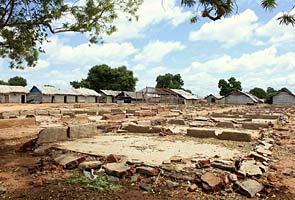In Sri Lanka, the civil war of the last 20 years finally came to a brutal end in 2009, when the Sri Lankan Army defeated the LTTE. Though the military war is over, the propaganda war refuses to die out. The government claims it is rebuilding lives and trust, but persistent charges of war crimes, and denial of rights to its Tamil population continue to plague the regime. In any conflict, or post-conflict environment, newsgathering is a complex process. But we attempted to address some of the burning questions faced by Sri Lanka in the aftermath of war.
First, the terms of reportage: We travelled unsupervised in all the civilian areas in the Tamil area of the North of Lanka - Jaffna, Kilinochchi, Mullaitivu, and Vavuniya. We were escorted by the army to the high security zones.
To begin from where it all ended - in a tiny strip of land along the island's northern coast, near the town of Mullaitivu, where the LTTE and the Army staged their final battle. The Army declared it a No Fire Zone in February 2009 and soon it was flooded with civilians trying to escape the onslaught of war. But the LTTE moved in, and the civilians were caught in a deadly crossfire between the Army and the LTTE. Much has been written about this, including a report commissioned by the UN Secretary General which says "The Government shelled on a large scale in three consecutive No Fire Zones". It also indicts the LTTE saying "Despite grave danger in the conflict zone, the LTTE refused civilians permission to leave". And so it is what unfolded here which remains the main prism through which the world is judging the government's post war response.
This high security area has been sealed off to the media since the war but for the first time, the government, to demonstrate they had nothing to hide, allowed us access. We first glimpsed it by air, from the army helicopter, and then by land.
We entered through the tranquil Nandikadal lagoon, where Prabhakaran's body was found. And then into landscape of utter devastation: miles and miles of charred vehicles with which people rushed here, and beyond the shattered remains of the villages of Mulivaikal that fell in the zone.
A full scale investigation of war crimes is beyond the scope of this report but with the sheer scale of destruction it was evident that the blood of innocent has been spilled here, and that no side is blameless.
As if any further proof was needed, we would come across photographs taken by Mathi (name changed on request), someone who lived in the no fire zone, and who barely survived. The images are a powerful timeline of what occurred: people pouring in on vehicles, unabated shelling from both sides, and the nightmare that followed.
And we would also hear voices of survivors in our travels, like an old man in the Manik Farms refugee camp who said the firing was coming from all sides.
We were taken to another devastated town nearby - Puthukkudiyiruppu or PTK, another near deserted museum of war. The Army says the process of demining has to be completed before it can be rebuilt again. PTK is part of the same disturbing geography that finds mention in the report commissioned by the UN Secretary General.
The report says "PTK hospital was hit every day by rocket launchers and... artillery".
As with the No Fire Zone, here again, the Army says they had no option since the LTTE had moved in the hospital compound.
But while that may have been true, as we walked around the hospital, the extent of the shelling seemed unduly severe. Every single room of the building, including the Operating Theatre was in ruins.
Despite this overwhelming evidence both existing and what we witnessed, the Army continued to be ambivalent about civilian lives lost in the No Fire Zones.

No comments:
Post a Comment